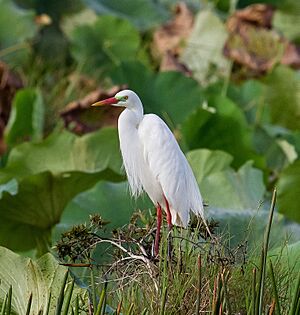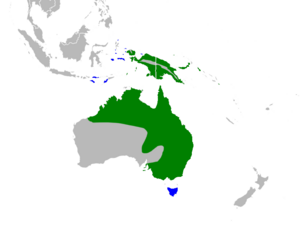Plumed egret facts for kids
Quick facts for kids Plumed egret |
|
|---|---|
 |
|
| Plumed egret in breeding plumage, Fogg Dam Conservation Reserve, Northern Territory, Australia | |
| Conservation status | |
| Scientific classification | |
| Genus: |
Ardea
|
| Species: |
plumifera
|
 |
|
| Resident Non-breeding | |
| Synonyms | |
|
|
The plumed egret (Ardea plumifera) is a type of heron bird. It lives in Australia and the surrounding islands in Oceania. This bird used to be thought of as a subspecies, or a type, of the intermediate egret. But now, scientists see it as its own unique species.
Contents
About the Plumed Egret's Name
The plumed egret was first officially named Herodias plumiferus in 1848. An English bird expert named John Gould gave it this name. He found it in New South Wales, Australia. For a long time, many people thought it was just a subspecies of the intermediate egret. However, on September 26, 2023, a group of bird experts called the International Ornithological Congress decided. They agreed that the plumed egret and two other similar birds are all separate species.
What Does the Plumed Egret Look Like?
The plumed egret is a medium-sized heron. It is about 56 to 70 centimeters (22 to 28 inches) long. This bird is completely white.
When it is time to breed, the egret grows long, fancy white feathers. These feathers appear on its chest and shoulders. Its beak also changes color to red or orange. The skin around its eyes turns green. Its upper legs become red, and its lower legs are black. When it is not breeding season, its beak is yellow-orange. The skin around its eyes is yellow, and its legs are all black.
Where Plumed Egrets Live
You can find the plumed egret in Australasia. This area includes Australia and nearby islands. They breed in places like eastern Indonesia, Timor-Leste, New Guinea, and Australia. Sometimes, they might fly to New Zealand or the Solomon Islands. These birds love shallow water areas. They live at the edges of freshwater wetlands and swamps. They also like coastal areas where the tide goes in and out.
Plumed Egret Life and Reproduction
The plumed egret hunts during the day. It looks for food in shallow water. It catches fish, frogs, water insects, and small crabs.
In Australia, these birds breed in late summer. They gather together in groups called colonies, often in trees. The female egret lays 3 to 5 pale bluish-green eggs. Both the male and female birds take turns sitting on the eggs. The eggs hatch after about 24 to 27 days. The young birds are ready to fly and leave the nest in about 5 or 6 weeks.


